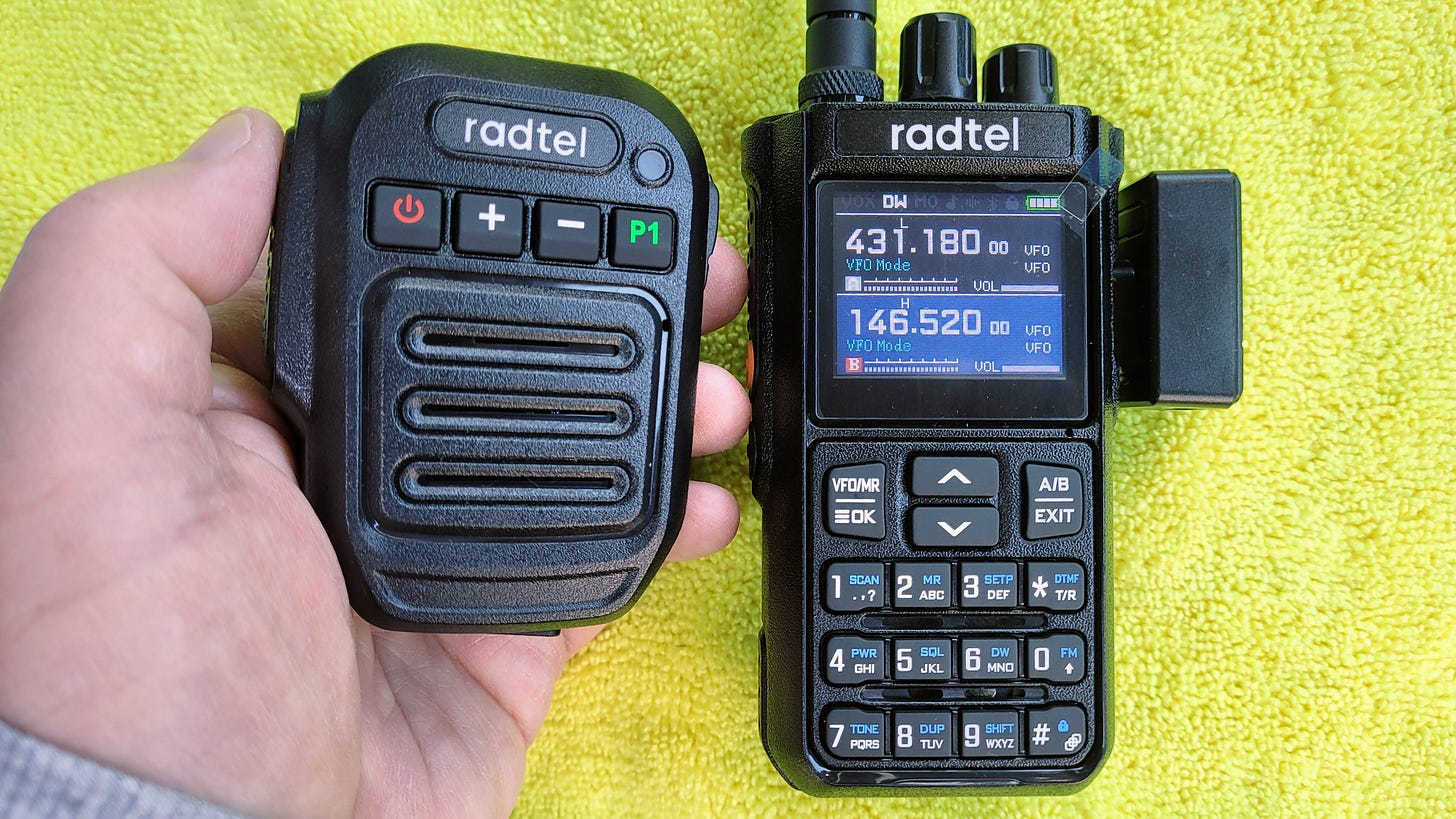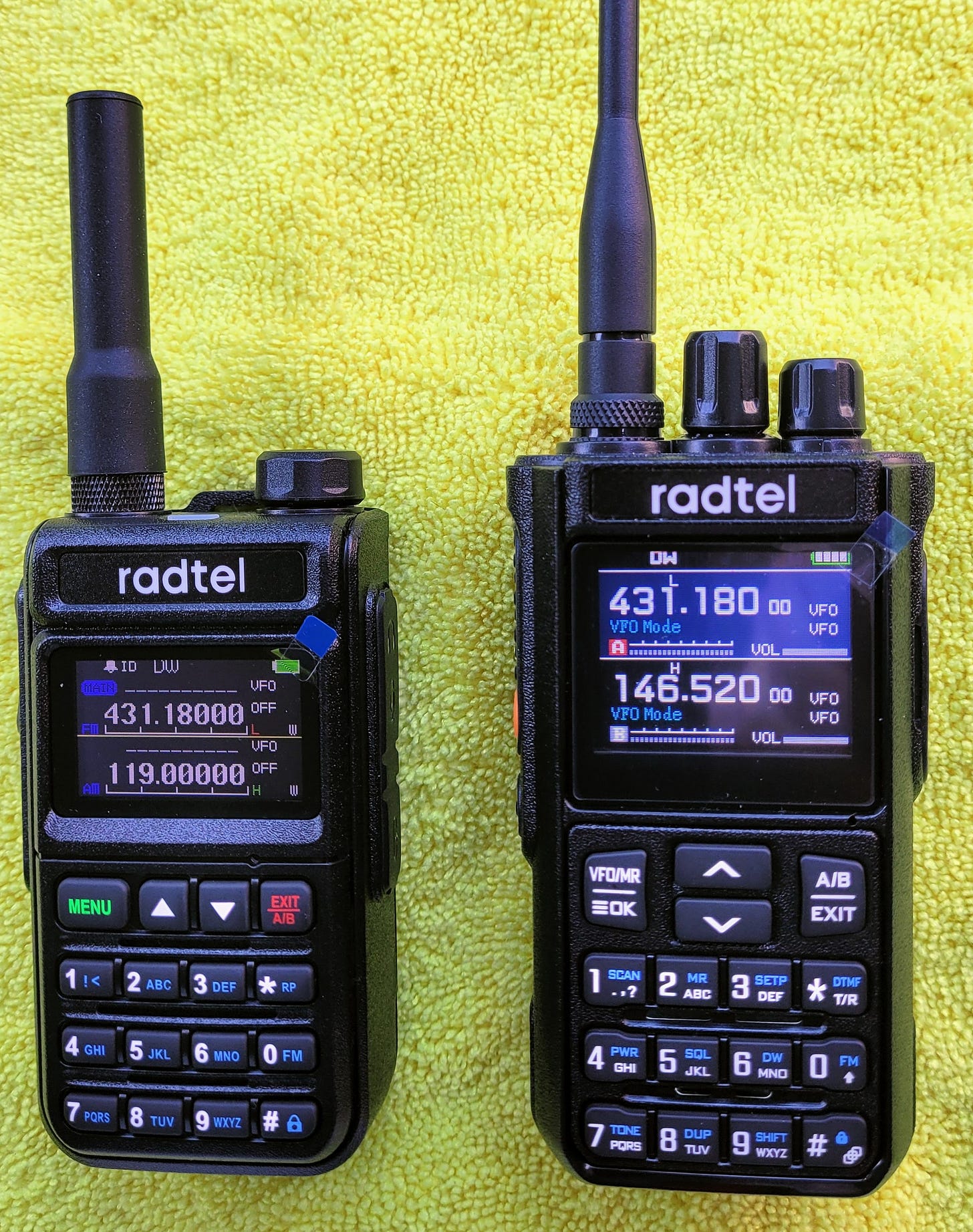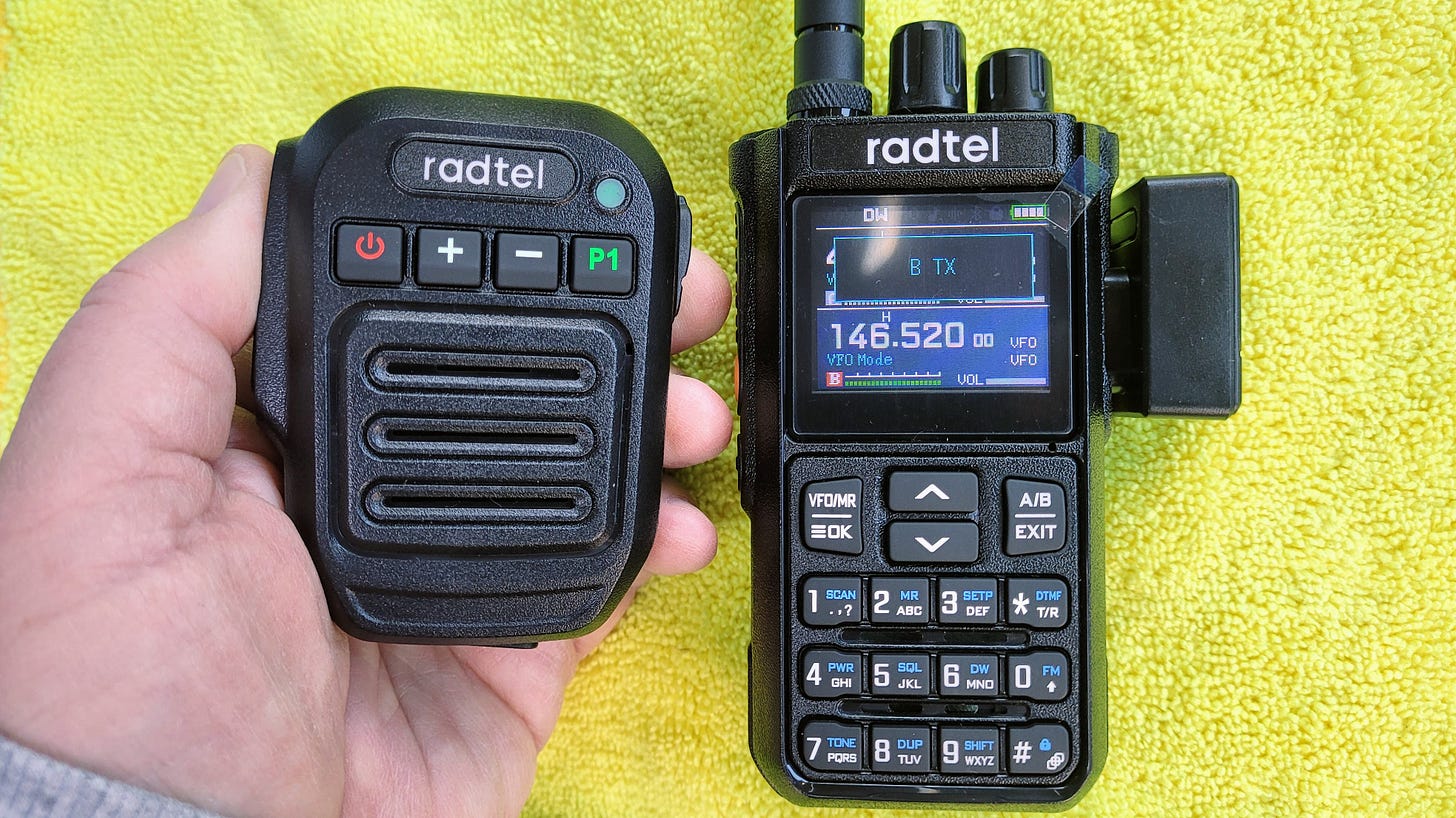Random Wire Review: Issue 134
June 5, 2025: First impressions of two low-end Radtel-brand radios, and a Radtel Bluetooth speaker-microphone!
I’ve spent the past month being present for my spouse who is recovering from a significant medical event. I’ve been sleeping on sofas, benches, cots, and occasionally the floor. It is not a particularly restful time and my attention has been focused primarily on my wife. Nevertheless, radio continues to provide some solace, diverting my mental energies when I give it time, and allowing me to connect with my amateur radio friends around the world.
While I haven’t invested much time in developing new content, I did find time to try a couple of radios. These are discussed below, albeit briefly.
Here’s the summary: I like the Radtel RT-900 radio better than the more compact RT-890. It feels more polished. However, I hope to try the Radtel RT-880, a bigger, more expensive radio. I ordered one directly from Radtel so it may not arrive before July. I chose the RT-880 without GPS. To that package, I added a programming cable and a tri-band antenna because the RT-880 also does the 222 MHz band! I’m looking forward to playing with the RT-880.
Radtel radios
I’ve been reading some good (although often mixed) reviews of Radtel radios. Since I am interested in VHF and UHF repeaters, and in airband monitoring, I purchased two different low-cost models of Radtel handheld radios with those bands, the Radtel RT-890 and the Radtel RT-900.
I chose the RT-890 partly because it was so inexpensive:
But at only a few dollars more, the RT-900 is also inexpensive:
You might think that since some of the features are similar and the model numbers are so close together, these two radios would be very similar. To me, they are not as alike as I had expected. They operate differently and they feel different, too.
First impressions
The RT-890 felt cheap when I held it. It is noticeably light in weight. Some of the controls feel a little too sticky or clicky. When I transmit, there is an audible clicky chirp at the end of the transmission. It may not be present in the transmitted signal (I did not hear it when I tested on a parrot node), but that electronic click or chirp is not what I am used to hearing. I find it a bit disconcerting.
In contrast, the RT-900 has some heft. It fits well in my hand. The controls are quieter and smoother than those on the RT-890. The RT-900 feels higher quality than the RT-890.
(By the way, the antenna in the picture of the RT-890 is not stock. I screwed on a stubby antenna for carrying the radio in my pocket.)
The RT-890 requires a 120VAC charging base to charge the battery. The RT-900 recharges with a USB-C cable, much more convenient than having to pack a charging base.
Setup
I first used the controls and menu on each radio to set up my first frequency. While the menus are not as logical as those in my Yaesu radios (and I know that Yaesu detractors will chuckle that I just described Yaesu menus as “logical”) they are not hard to navigate. For the most part, the menu descriptors are clear enough.
I set up the RT-890 for my AllScan node frequency. That went smoothly and I was “on the air” through my AllScan node within minutes. However, I had trouble with the RT-900. First, I got the CTCSS tone wrong so I wasn’t hearing any audio (my fault). Second, the receiver seems to go mute whenever the radio screen goes dark. I fixed this latter behavior by turning the backlight on all the time, meaning that when the radio is on, the display is also on. There is no setting that says display or backlight. Instead, it is oddly named ABR in menu position 6. Still, once I resolved the CTCSS tone problem and configured the screen backlight to be on all the time, the RT-900 worked fine.
I note that I emailed Radtel support but did not receive a response. You may need to use their social media presences to get support. The best help I got was in the Radtel Two Way Radios group on Facebook.
VHF/UHF audio
I have these radios in a “radio hole” a few of us locally call the “Vortex.” It seems to consume RF coming in and going out. The tests I did of audio were done over AllScan.
The RT-890 seems a bit louder than the RT-900, but the RT-900 audio is smoother sounding. The RT-890 has a bit of rasp in the received audio. I prefer listening to the RT-900.
Airband
We’re not too far from the Bremerton National Airport so I used the RT-900 to listen to the CTAF (Common Traffic Advisory Frequency) frequency of 123.05 MHz. Unfortunately, I did not have my airband antenna with me, but the transmissions were intelligible. The radio automatically switches to AM when the airband frequency is entered.
Updating firmware
I also updated the RT-900 to the latest firmware. How to actually accomplish this was a little confusing. I purchased a USB-to-K1-adapter programming cable for the princely sum of $6.99:
Finding the latest firmware was not entirely obvious but it didn’t take much time to locate it. Figuring out how to run the update took a little more in the way of making intuitive leaps because the program to install it was hidden inside the firmware package. Find firmware for Radtel radios at https://www.radtels.com/pages/software-download.
Of course, if you’ve done this kind of thing before, you know you first must install the driver for the programming cable, then find the COM port for the driver. I ran Device Manager on my Windows 11 machine, opened the Ports listing, and saw the adapter was on COM3 for my installation.
Bluetooth speaker-microphone
While I was fiddling around with these two radios, I also tried a Radtel-branded Bluetooth speaker-mic.
With the RT-890, I could receive audio over the Bluetooth speaker-mic but could not transmit. (To be fair, the RT-890 is not listed as compatible with this Bluetooth device, but I wanted to try it anyway.) With the RT-900, it worked well for both transmit and receive. In the image below, you can see the popup on the radio (“B TX” does not mean Bluetooth transmit — it means transmitting on VFO B) when I transmit wirelessly from the Bluetooth speaker-microphone.
I also tried it with a TIDRADIO TD-H8 handheld (because: why not?) and found it did not work with that radio.
A note on last week’s issue
One section in last week’s issue of the Random Wire got a little extra attention. The content titled “The importance of internet-connected systems for amateur radio community and connections” was featured in the Zero Retries newsletter issue 204. Many thanks to newsletter creator and editor Steve Stroh for sharing that piece because it resulted in some great interactions with subscribers.
I’ve heard from some folks who are in the situations I described. Here’s a partial quote from one of those emails that really drives the point of that piece home:
I am a single person in a Senior Living Facility. While I am thankful to be here I have almost no interaction with my neighbors. Amateur radio over the internet supplies my daily interaction with the outside world. I belong to two large active linked repeater systems…internet connected radio is a big part of my life. It gives me a great social life. Without those Internet connected devices, I would be very lonely.
Whether it is “real radio” or not, internet-connected amateur radio serves a segment of our radio community that benefits from such systems. The amateurs who use them bring a lot of knowledge and life experience to our radio community. I am glad these systems exist, are being actively improved, and help build community among radio amateurs around the world.
That’s the report from the lake house and skilled nursing facility. Thank goodness we have amateur radio to keep us sharp, occupy our active minds, and connect us to like-minded radio friends!
73 to all and remember to touch a radio (even an internet-connected radio) every day!








https://kd1mu-radio.com/shop/kd1mu-dual-band-uv5118-radio-manufactured-by-iradio/
Thinking about you both, Tom!